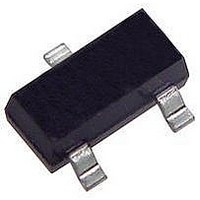HSMS-286E-TR1G Avago Technologies US Inc., HSMS-286E-TR1G Datasheet - Page 6

HSMS-286E-TR1G
Manufacturer Part Number
HSMS-286E-TR1G
Description
DIODE SCHOTTKY DETECT HF SOT-323
Manufacturer
Avago Technologies US Inc.
Datasheet
1.HSMS-2860-BLKG.pdf
(18 pages)
Specifications of HSMS-286E-TR1G
Diode Type
Schottky - 1 Pair Common Anode
Voltage - Peak Reverse (max)
4V
Capacitance @ Vr, F
0.25pF @ 0V, 1MHz
Package / Case
SC-70-3, SOT-323-3
Diode Case Style
SOT-323
No. Of Pins
3
Peak Reflow Compatible (260 C)
Yes
Leaded Process Compatible
Yes
Forward Voltage
350mV
Repetitive Reverse Voltage Vrrm Max
4V
Pin Count
3
Forward Current If
1mA
Rohs Compliant
Yes
Lead Free Status / RoHS Status
Lead free / RoHS Compliant
Current - Max
-
Power Dissipation (max)
-
Resistance @ If, F
-
Lead Free Status / Rohs Status
Compliant
Available stocks
Company
Part Number
Manufacturer
Quantity
Price
Part Number:
HSMS-286E-TR1G
Manufacturer:
AVAGO/安华高
Quantity:
20 000
Appli cations Information
Introduction
Avago’s HSMS‑286x family of Schottky detector diodes
has been developed specifically for low cost, high
volume designs in two kinds of applications. In small
signal detector applications (P
used with DC bias at frequencies above 1.5 GHz. At lower
frequencies, the zero bias HSMS‑285x family should be
considered.
In large signal power or gain control applications
(P
frequencies above 4 GHz. At lower frequencies, the
HSMS‑282x family is preferred.
Schottky Barrier Diode Characteristics
Stripped of its package, a Schottky barrier diode chip
consists of a metal‑semiconductor barrier formed by
deposition of a metal layer on a semiconductor. The most
common of several different types, the passivated diode,
is shown in Figure 7, along with its equivalent circuit.
Figure 7. Schottky Diode Chip.
R
of the bondwire and leadframe resistance, the resistance
of the bulk layer of silicon, etc. RF energy coupled into
R
output of the diode. C
of the diode, controlled by the thickness of the epitaxial
layer and the diameter of the Schottky contact. R
junction resistance of the diode, a function of the total
current flowing through it.
where
I
from picoamps for high barrier diodes to as much as 5
µA for very low barrier diodes.
6
R
S
S
S
in
I = I
n = ideality factor (see table of SPICE parameters)
T = temperature in °K
I
I
is a function of diode barrier height, and can range
j
is the parasitic series resistance of the diode, the sum
is lost as heat — it does not contribute to the rectified
S
b
> ‑20 dBm), this family is used without bias at
=
=
= saturation current (see table of SPICE parameters)
= externally applied bias current in amps
N-TYPE OR P-TYPE SILICON SUBSTRATE
8.33 X 10
N-TYPE OR P-TYPE EPI
PASSIVATION
S
I
0.026
S
(exp
+ I
CROSS-SECTION OF SCHOTTKY
I
S
b
BARRIER DIODE CHIP
+ I
(
at 25
V - IR
-5
b
0.026
METAL
SCHOTTKY JUNCTION
n T
°
C
HSMS-285A/6A fig 9
S
= R
)
LAYER
J
is parasitic junction capaci tance
PASSIVATION
- 1)
V
- R
in
s
< ‑20 dBm), this diode is
EQUIVALENT
C
j
CIRCUIT
R
S
R
j
j
is the
The Height of the Schottky Barrier
The current‑voltage character istic of a Schottky barrier
diode at room temperature is described by the following
equation:
On a semi‑log plot (as shown in the Avago catalog) the
current graph will be a straight line with inverse slope
2.3 X 0.026 = 0.060 volts per cycle (until the effect of R
seen in a curve that droops at high current). All Schottky
diode curves have the same slope, but not necessar‑
ily the same value of current for a given voltage. This is
deter mined by the saturation current, I
the barrier height of the diode.
Through the choice of p‑type or n‑type silicon, and the
selection of metal, one can tailor the characteristics of a
Schottky diode. Barrier height will be altered, and at the
same time C
low barrier height diodes (with high values of I
for zero bias applica tions) are realized on p‑type silicon.
Such diodes suffer from higher values of R
the n‑type. Thus, p‑type diodes are generally reserved
for small signal detector applications (where very high
values of R
used for mixer applications (where high L.O. drive levels
keep R
Measuring Diode Linear Parameters
The measurement of the many elements which make
up the equivalent circuit for a pack aged Schottky diode
is a complex task. Various techniques are used for each
element. The task begins with the elements of the diode
chip itself. (See Figure 8).
Figure 8. Equivalent Circuit of a Schottky Diode Chip.
R
curve is measured for the diode under forward bias, and
the slope of the curve is taken at some relatively high
value of current (such as 5 mA). This slope is converted
into a resistance R
For n‑type diodes with relatively low values of saturation
current, C
tance (see AN1124). R
lated using the equation given above.
S
I = I
j
is perhaps the easiest to measure accurately. The V‑I
=
I
S
0.026
V
S
(exp
low) and DC biased detectors.
+ I
R
R
I
j
S
V
S
is obtained by measuring the total capaci‑
b
S
swamp out high R
+ I
R
J
(
= R
at 25
and R
V
V - IR
b
= R
0.026
d
d
-
.
°
j
R
C
S
+ R
0.026
V
C
S
j
)
will be changed. In general, very
j
, the junction resistance, is calcu‑
I
f
S
- 1)
V
s
S
) and n‑type diodes are
S
, and is related to
S
S
, suitable
than do
S
is


























